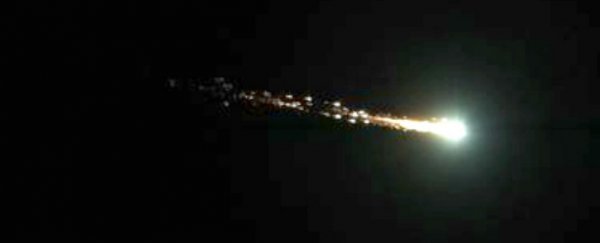We might think we've got a pretty good handle on what space junk is bombarding Earth's atmosphere and where, but in reality, our planet is being visited by about 90 tonnes of cosmic debris every single day, and sometimes even the big bits get missed.
Case in point - the largest fireball since 2013's epic Chelyabinsk explosion burned up over the Atlantic Ocean earlier this month, and thanks to it occurring about 1,000 km off the coast of Brazil, no one was around to witness it.
While obviously no one got hurt by the fireball - which astronomer Phil Plait says likely detonated 30 km above the Atlantic Ocean with the energy equivalent of around 12,000 tonnes of TNT - the fact that NASA scientists only know about it thanks to details disclosed by the US military is a little disconcerting.
"[O]nce they get into the 20 to 50-metre range … explosions from impacts like that rival nuclear bombs," Plait points out over at Slate. "Happily, they're very rare - here we're talking fewer than once per century, statistically speaking - but it would be nice if we knew they were coming. It's hard to say just what we would do if we saw one, but right now, we don't even have that option."
To be clear, the worry isn't that we weren't prepared for this fireball in particular, because it exploded many kilometres over the open ocean, and despite being the biggest one since Chelyabinsk, was no where near as big.
According to Plait, the Chelyabinsk fireball exploded over Russia in February 2013 with the force of a staggering 45,000 tonnes of TNT, which was strong enough to shatter windows and injure over 1,000 people.
Even if this one happened to explode over land, it's unlikely to have done much damage. That's the beauty of Earth's atmosphere - this thing could have been a rock the size of a living room, hurtling towards us at speeds of up to 100 kilometres per second, but the vast majority of the time, our atmosphere causes debris like this to disintegrate, burn up, or explode way before impact.
But that doesn't mean such events will always be harmless, as this giant bruise can attest to.
NASA's Near-Earth Object team became aware of the February 6 event after the US military let it know the bare-bones details of the event.
It's unclear what the military did to record the event, or how much information they have on it - because, surprise, surprise, they don't want us know what they've been monitoring and where - but Plait says data could have been picked up by satellite observations, seismic monitors, or atmospheric microphones.
"I understand the desire for them to keep their technology and capabilities secret," he says. "It would be nice scientifically to have this data available, but then again they don't have to release any of it at all, so even having this much is better than nothing. And it's useful."
Basically, if we want to get something done for science, we have to do it ourselves, and fortunately NASA's Near-Earth Object Program recently received a huge funding boost to get the job done.
We're still only detecting about 10 percent of all asteroids 140 metres and larger zipping relatively close to Earth, so we're not out of the woods yet, but astronomers aren't too worried. "All known Potentially Hazardous Asteroids have less than a 0.01 percent chance of impacting Earth in the next 100 years," NASA reported late last year.

